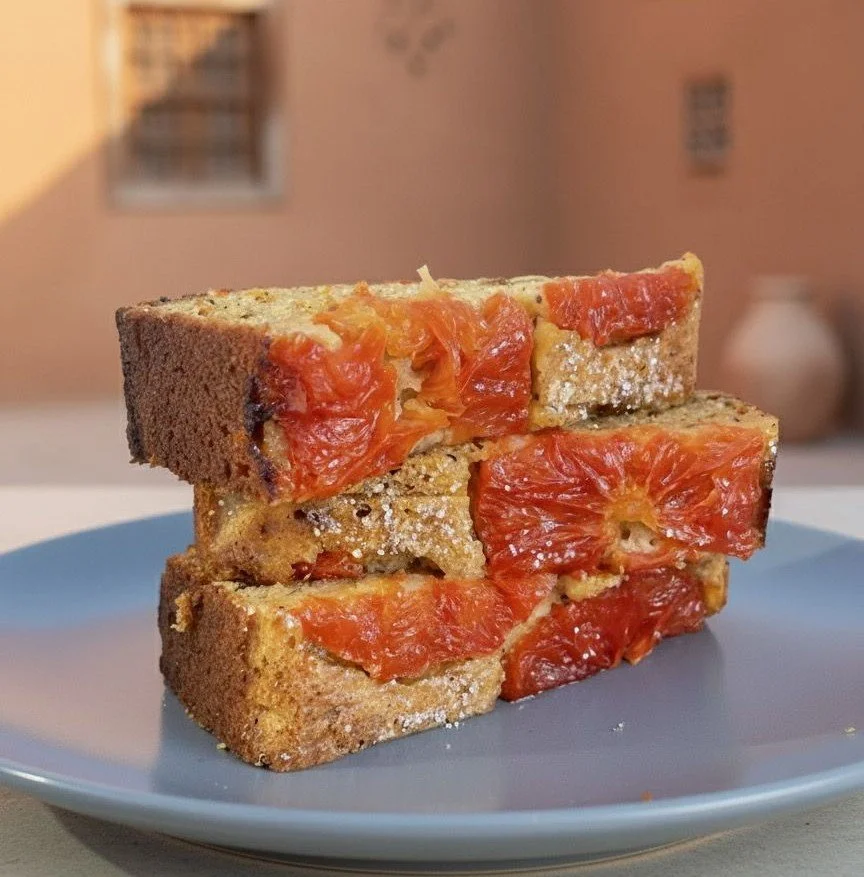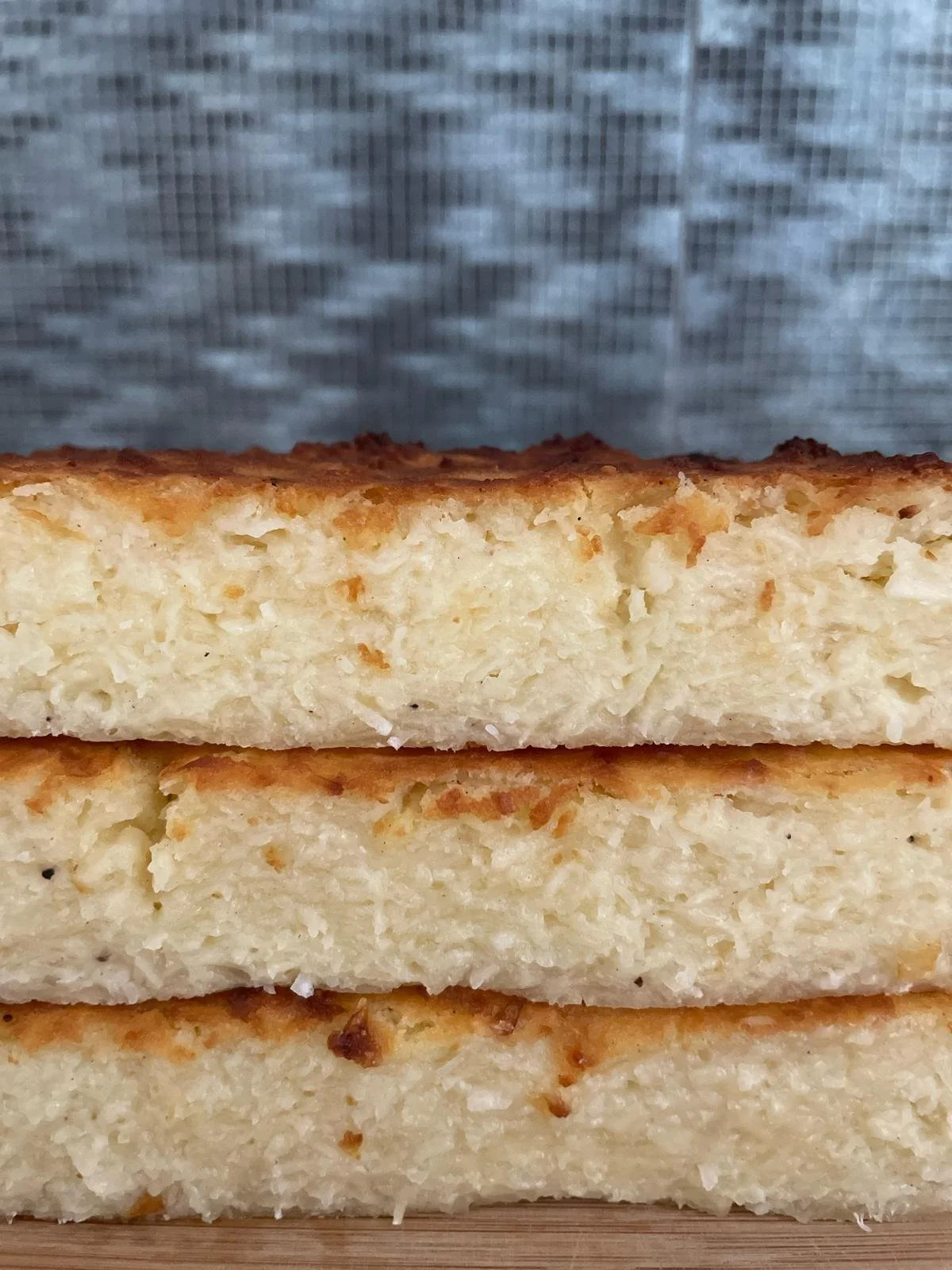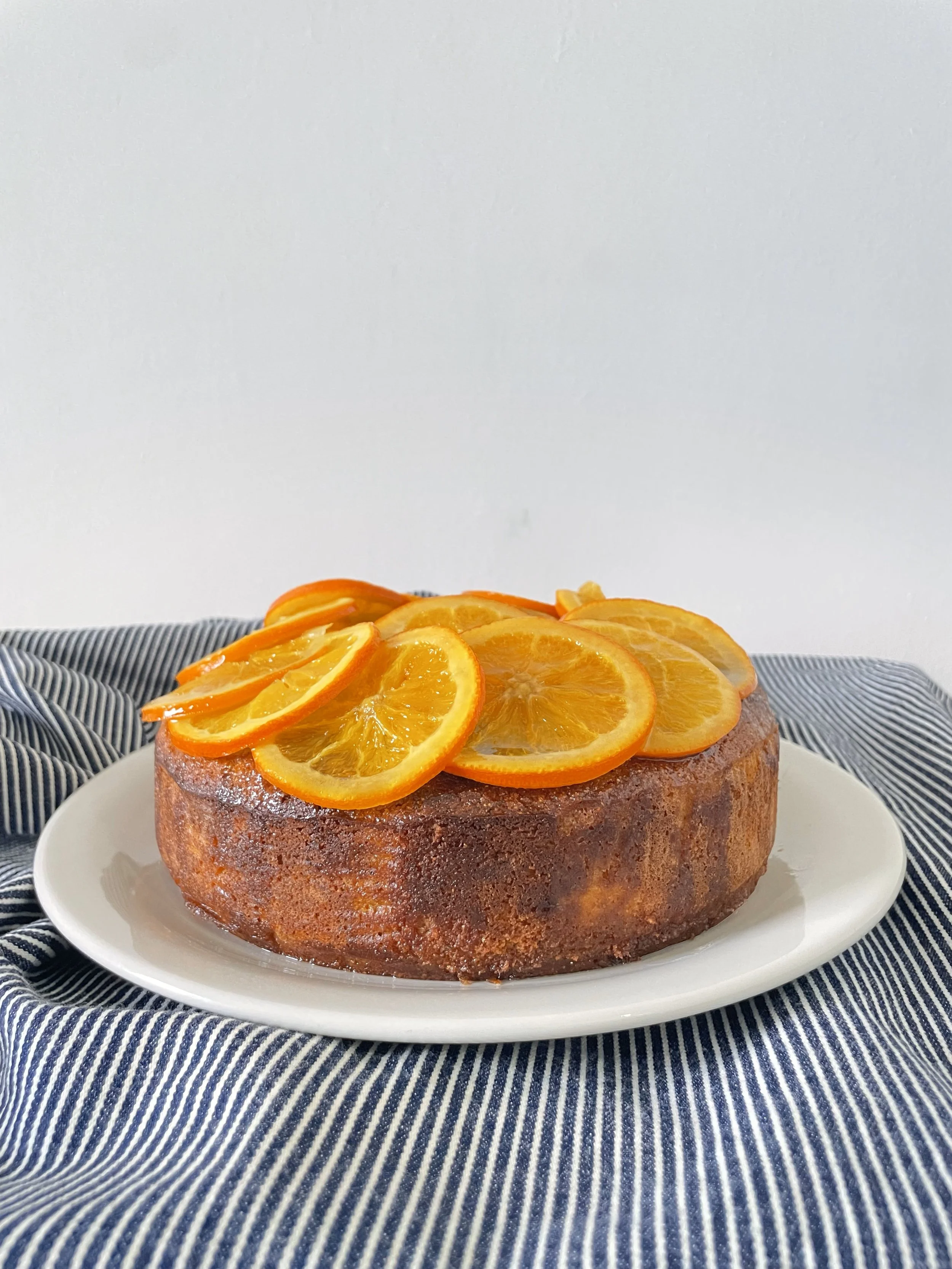explore the world through the universal language of food
Damper with Almond & Wattleseed Dukkah
The Recipe
Makes: 1 x 20cm damper
Preparation: 10 minutes
Baking Time: 25-35 minutes
Damper is a simple ‘bush tucker’ bread that was made by stockmen who were in remote areas for many weeks and days at a time. This simple bread was mixed and ‘damped’ into the coals of a campfire until it was cooked through.
From a simple recipe of water, flour and a bit of salt…. You have all the ingredients you need to make traditional Australian damper. Damper is a simple ‘bush tucker’ bread that was made by stockmen who were in remote areas for many weeks days at a time. This simple bread was mixed and ‘damped’ into the coals of a campfire until it was cooked through.
Over time damper recipes have been altered and made with milk, butter, sugar and baking powder. The texture, however, remains the same – a dense bread with a crispy exterior. Damper must always be paired with the Australian nickname for golden syrup, “Cocky’s Joy”.
Dukkah, originally an Egyptian condiment of nuts, herbs and spices has become extremely popular in Australia with everyone making their own versions. It originally is a savoury dish but I’ve made mine sweet to pair with the damper. Dukkah is also a beautiful thing to be sprinkled on yoghurt, ice cream or granola.
When you are making damper at home, you don’t need a campfire… An oven will do the job. For this recipe, I baked my damper in a cast-iron skillet which resulted in a pretty good texture.
INGREDIENTS
DAMPER
350g plain flour
2 tsp baking powder
½ tsp fine sea salt
160mls water
50g butter
DUKKAH ( makes 130g)
100g almonds, skin on
10g/2tblsp of roasted ground wattleseed
¼ tsp ground ginger
2 tsp black sesame seeds
18g/3 tsp brown sugar
A pinch of salt
*You can substitute with aniseed, caraway, or fennel.
METHOD
Preheat the oven to 200’C
Mix salt and flour with baking powder and rub in the butter so it resembles coarse breadcrumbs.
Add in the water and mix until combined.
Knead the dough on a well-floured surface until smooth
Shape into a 20cm disk and place in the oven in a skillet or baking tray
Dip a sharp knife in flour and score the top into wedges and sprinkle with a little flour.
Bake in the oven for 35-35 minutes… when turned out and knocked on the bottom it should sound hollow
Dust with flour, serve with butter, cocky’s joy and dukkah.
Toast the almonds in the oven or in a frying pan. Set aside and allow to cool completely
Toast the black sesame seeds, you can use white sesame seeds if that works for you
In a food processor, lightly pulse the nuts, sesame seeds and then add the sugar, salt, ginger and herbs.
Mix until well combined
Dukkah should have a nice crunchy texture so it is important not to blend the nuts and sesame seeds too much.
Black & White Tsoureki
The Recipe
Makes 4 20cm x 10xm braids
Preparation: 2 hours (including proving time)
Baking Time: 20-25 minutes
Tsoureki comes from the Turkish word “Corek”, which is referred to any bread made from a yeast dough.
As Easter comes around year by year - I always want to make something different from your normal hot cross bun. Don’t get me wrong - I love hot cross buns with plump juicy raisins, slightly toasted and smothered in salted butter, but I also like to learn something new and see if it exceeds my expectations.
Tsoureki comes from the Turkish word “Corek”, which is referred to any bread made from a yeast dough. The bread evolved from Byzantine times and was originally molded into a variety of shapes to ward off evil spirits. Now, in Greece it is commonly braided into a wreath and dotted with red eggs that symbolise the blood of Jesus.
Now the tradition of Easter today and the Pagan Festival of Spring equinox does overlap somewhat. Easter, supposedly named after Eostre, a goddess was symbolised by a rabbit or hare. Traditions of baking, exchanging eggs and are related to rebirth, generation and change.
Whether it is a traditional celebration, the resurrection of JC or the official start of spring - it’s always a wonderful excuse to find chocolate eggs the mysterious Easter bunny has hidden and also to bake in your pjs.
I have included the recipes for both of my versions of tsoureki that follow the same method – do let me know what version you liked the best!!!
INGRDEDIENTS
CHOCOLATE & CHERRY TSOUREKI
10.5g yeast
210g plain flour
A pinch or two of salt
40g cocoa powder
80mls milk
50mls warm water
1 medium egg (50g)
70g caster sugar
1 tsp vanilla extract
70g dried cherries
40g unsalted butter
ANISEED TSOUREKI
10.5g yeast
250g plain flour
A pinch or two of salt
50g caster sugar
1 medium egg (50g)
70mls milk
50mls warm water
Zest of an orange
40g butter
Good chocolate Easter eggs are difficult to find in Singapore (they don’t celebrate it much here!) so to satisfy my chocolate craving I baked a chocolate sour cherry version of tsoureki and he traditional recipe uses mahlepi (a spice made from the seeds of a certain type of cherry) but I threw in some aniseed because - why not??
METHOD
Preheat the oven to 180’ celsius
Put the flour, sugar, yeast, salt and cocoa (if using) into the mixing bowl
Separately mix milk, egg, aniseed, zest and 50mls warm water
Mix the two together with dough hook until a soft dough forms (at this stage you can add the cherries if you are using them)
Lastly add in the butter bit by bit until combined
Throw the mixed dough that’s nice and supple into a well greased bowl (olive oil or melted butter will do the trick), cover and set aside until the dough has doubled in size.
Knock back the dough with a fist or two and divide it into 9 equal portions and plait 3 reasonably similar braids
Place the braids on a tray lined with baking paper and brush with
Brush the braids with egg wash and poke in the dyed eggs randomly in the dough
Bake for 20-25 minutes
Brush with melted honey or jam of your choice for a nice sticky glaze
Although this recipe is supposed to be made on a Thursday and eaten on a Sunday – best you eat it on the day it’s baked!
TO DECORATE
18 dyed quail eggs.
The quail eggs are boiled and cooled and dipped in baths of a teaspoon of vinegar, 1/2 cup water and a good dash of food colouring and stored overnight. Drain the eggs and allow them to completely dry on a cake rack before using.
Pan de Muerto
The Recipe
Makes: 8 large buns
Preparation: 20 minutes plus proving time
Cooking Time: 30-40 minutes
Pan de Muerto is a traditional Mexican sweet bread that's commonly enjoyed during Dia de los Muertos, a holiday that celebrates and honors deceased loved ones.
Back when I was living in Mexico I learned how to make this bread.
It is an iconic symbol of Dia de los Muertos or Day of the Dead. It is one of the symbols that are placed at offrendas or altars that will coax and feed the souls as they return to their loved ones once a year.
Learn more about Dia de los Muertos HERE.
You are more than welcome to freeze this bread and heat it up when you get a craving, but if you taste it straight out of the oven you will not stop at just one. Enjoy the recipe and let me know how it goes!!
INGREDIENTS
14g instant dry yeast
1 cup / 235mls whole milk
4 medium eggs
2 oranges, zest and juice (approximately ¾ cup juice)
170g unsalted butter
180g caster sugar
2 tsp aniseed
¼ tsp fine sea salt
800g plain flour
Extra flour for rolling
1 egg for egg wash
GARNISH
100g sugar
100mls orange juice
120 g fine caster sugar for sprinkling
METHOD
Mix 50g sugar, yeast, ½ cup warm milk, and ¾ cup flour. Allow sitting for about 20 minutes to activate the yeast.
Whisk the rest of the sugar, milk, eggs, zest and juice, aniseed in a separate bowl
Sift flour and salt separately.
Whisk the egg and yeast mixture together.
In an electric mixer, on low speed with the dough hook attached, pour in the wet mixture and add 1/3 of the flour. Add ½ of the melted butter and allow to mix for about 3 minutes. Continue this until both butter and flour is mixed in.
Mix for 5-8 minutes at a medium/high speed until everything is incorporated and the dough comes away from the sides of the mixing bowl.
Transfer the mixture into a large, oiled container with a secure lid. Allow to rise for about an hour, or until it has doubled in size, and then transfer to the fridge to sit overnight.
Make sure the container is big enough as the dough will rise quite a bit.
The next day….
Preheat the oven to 180’C
Turn out the dough on a floured surface and shape 8 x 150g balls of dough. Place on a lined baking tray.
With the remaining dough, shape 16 lengths of dough (15 cm each), the thickness of a pen.
Make small balls at the ends of the dough, and place them on the buns so they cross over.
Roll a small ball of dough and place it in the centre of the crosses.
Brush with egg yolk and bake in the oven for 30-40 minutes
Heat 100g sugar and orange juice in a small saucepan until the sugar has dissolved
When the bread is ready, take it out of the oven and allow it to rest for about 5 minutes before transferring it to a cooling rack.
Brush with orange juice sugar mixture and dust generously with sugar.
Store in an airtight container or the bread can be frozen for up to 3 months.
CHOCOLATE PECAN BABKA WITH MAPLE GLAZE
The Recipe
Makes: 1 medium loaf
Preparation: overnight proofing
Baking Time: 30-40 minutes
The traditional babka, meaning “Little Grandmother” is an Eastern European bread that is dense, rich and light all at the same time. Swirled with chocolate, nuts and cinnamon – this was only a version that seemed to develop mid-century by the American Jews.
Babka is not the easiest bread to make but it is also not the most difficult. It takes a bit of time and patience, a lot of love but the benefits and joys of munching down on this nutty, dense, chocolatey bread is worth it.
A sweet, yeasted bread that finds its origins in Eastern Europe, developed by the Ashkenazi Jews in Poland, Ukraine, Russia, and Lithuania. This Jewish community has a very coloured history with ancestral routes tied to Germany and Austria. It is a bread that is traditionally served on special occasions such as the Jewish Sabbath (Shabbat) or holidays and represents good fortune and prosperity.
It can be found throughout the year in Jewish bakeries around the world and there are many variations of babka that exist today, yet the original recipe was either a plain or nut-filled dough that was braided and then baked into a tall cylindrical shape.
This chocolate version is messy and extremely delicious and I hope you have fun making it!
THE INGREDIENTS
BABKA DOUGH
280g plain flour
60g white sugar
7g instant yeast
150mls milk, room temperature
Zest of 1 orange
½ tsp vanilla essence
2 x medium eggs
¼ tsp salt
140g butter, cubed
Oil (for greasing)
CHOCOLATE FILLLING
120g unsalted butter, room temperature
1 tsp cinnamon
2tblsp/20g cocoa
80g brown sugar
Pinch of salt
80g semi sweet chocolate, roughly chopped or chocolate chips
80g toasted pecans, roughly chopped.
GLAZE
50g maple syrup
10g butter
THE METHOD
The Day Before
Mix milk with vanilla, salt, and eggs
Place the sugar, yeast, zest, and flour in a mixing bowl with a paddle attachment
Add milk mixture to the flour until combined
Switch to a dough hook and then start adding the butter, bit by bit until all is incorporated.
Mix for about 5-8 minutes until the dough is nice and smooth
Place in a well-oiled bowl and cover with cling film and allow the dough to rise and double in size then place in the refrigerator overnight so it can work its magic
The Next Day
Turn the dough out onto a well-floured surface and roll it out into a rectangle 25cm width x 40cm length
For the chocolate filling, mix cinnamon, sugar, cocoa, and butter together until combined.
Have it on stand-by for when the dough is ready to be rolled.
Spread the chocolate mixture over the surface of the dough, leaving about a 1.5cm edge all aroundRoll the dough lengthwise to form a 25cm cylinder. Place in the fridge for about 10-15minutes to firm up (you will thank me for this later)
Take out the dough and with a sharp knife, cut it in half so you have long strips
Braid the two pieces of dough over each other so they are nicely twisted firmly together
Place into a greased and lined loaf tin (about 20cm in length), cover with a damp cloth, and allow to rise for 30-40 minutes. For the maple glaze, heat the ingredients at a low temperature until the butter is just melted.Preheat the oven to 190’C and bake the babka for 30-40 minutes until well risen and golden.
Allow the bread to cool slightly before turning it out and brush the babka while still warm with the maple glaze













